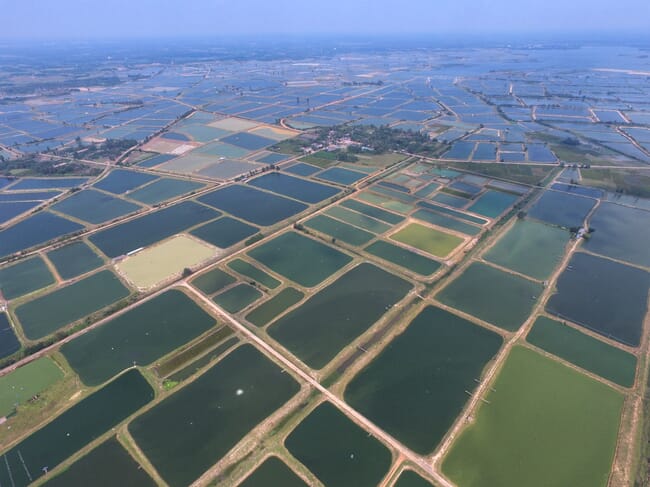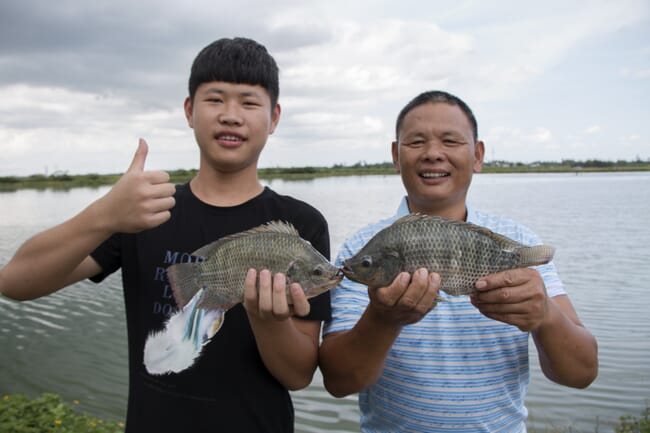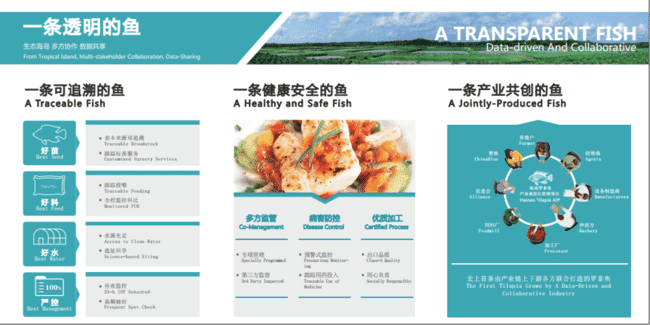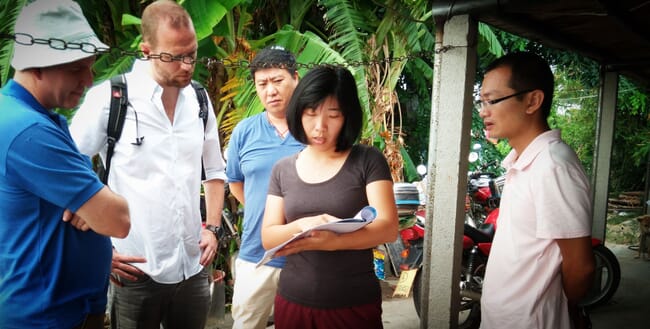So explains Han Han, the driving force behind the Hainan Tilapia Sustainability Alliance – a trade body she established under the auspices of China Blue, the NGO she set up after leaving the Sustainable Fisheries Partnership (SFP). Founded in 2015, it aims to support and improve the sustainability of the smallholder farmers who account for the vast majority of the island’s tilapia harvests.

Testing times
While China’s tilapia sector has experienced challenging times in recent years – the 2019 US-China trade war hitting exports, and the Covid-19 pandemic causing all manner of logistical problems – the alliance is now going from strength to strength, according to Han.
“There have been tensions and pressures in the Chinese economy and how we do business is totally different to how it was 2-3 years ago. And Covid-19 initially gave people a fear of seafood. Combined with the closure of restaurants it had a negative impact on demand for tilapia, which led to a reduction in prices,” she reflects.
However, she feels that – in the longer-term – the events of the last few years might offer a number of positives for farmers who are engaged in more sustainable aquaculture practices.
“On the positive side for us, the government is taking environmental risks more seriously and Covid-19 rang the bell for people to think more about health and the environment,” she adds.
As a result Hainan’s tilapia production has, according to Han, remained relatively stable, despite the uncertain times.
“The 2021 statistics aren’t yet available but there are between 2,000 and 3,000 farms on the island and the total production will probably be around 300,000 tonnes. 80 percent of Hainan’s tilapia are produced by smallholders and 90 percent produced in ponds,” explains Han.

“Prices improved in 2021 after a poor year in 2020, thanks to improvements in the export market – in particular to the US. But farmers are still facing challenges – in particular related to climate change and the increase in extreme weather events: with high temperatures and thunderstorms both becoming more frequent, which has increased the occurrence of disease outbreaks, in particular streptococcus,” Han reflects.
The Hainan Tilapia Sustainability Alliance
Han was inspired to set up the HTSA after a visit to Scotland in 2013, in which she met members of the Scottish Salmon Producers Association (SSPO) and learned about the impact of their code of good practice (COGP).
“When I came back, I worked hard to convince the major players across the tilapia value chain – including farmers, feed companies, service providers and processors – to form an alliance to promote and brand Hainan tilapia,” she recalls.
“And I explained the need to promote best practices – from the hatchery to the processing plant – to ensure good quality fish,” Han adds.
In her role as CEO of China Blue, she has been instrumental in the formation and running of the HTSA.
“We are close partners and have been working hand-in-hand over the last 6-7 years,” she notes.
While, to Western readers, the formation of such a trade body might not seem wildly impressive, it was very much ahead of the curve in China.
“The alliance was a very new concept. Most industry associations in China are government-led, but this was a bottom-up approach. It was the first one that really took the initiative to advocate out own desire for increased sustainability,” Han explains.
“As a result, no one had the experience, so we had to learn through trial and error as we tried to engage with local partners, local government imports and exporters. It wasn’t straightforward,” she adds.
Joining the alliance
The alliance now has nearly 500 members – accounting for about a third of Hainan’s tilapia production all of whom are expected to follow the body’s code of good practice, although Han admits that practices vary between farms.

“In the first 4-5 years, thanks to sponsorship from IDH, we were able to provide more training as well as projects to demonstrate the latest farming techniques and equipment,” says Han.
Since then, training provision has been more piecemeal, says Han, although she has seen a number of improvements in farming practice in the seven years since the alliance was founded.
“Most farms have increased their aeration, there’s an increase in the use of water quality sensors and a greater degree of data capture, thanks to the work of the alliance,” she explains.
And, as well as improving farm performance, the increase in data capture has improved the traceability of the supply chain. The alliance helped to set up a system in which it is possible to use these data to reward those farmers who have adopted the best practices, by offering them a 20 cent premium on every 500 g of tilapia they sell.

While laudable, this idea has not been as successful as Han had hoped.
“Buyers and retailers weren’t willing to pay the extra because it’s not attached to a certification scheme. And certification is too complicated for most smallholder farmers, so we have now set up a pilot project to see if data flow can be sufficient across the supply chain [to convince buyers of its credibility],” says Han.
Growth in numbers
Despite such challenges, membership of the alliance has increased dramatically since the outbreak of the pandemic – especially after the organisation decided to change its strategy and concentrate on working with farmers rather than the downstream end of the value chain.
And the generosity shown by members of the alliance during the peak of the pandemic was notable – they made regular donations of tilapia to medical workers in Wuhan, in an initiative co-ordinated by the alliance, in the face of severe logistical difficulties.
“It showed that the alliance could help famers work together and farmers also saw how the alliance could act as their voice,” Han reflects.
The credibility of the alliance has not only increased with farmers following the pandemic. It has also been integral to the provision of government insurance payouts to those farmers whose livelihoods were impacted by Covid-19.
“We have helped insurance agents establish if farmers qualify for government-subsidised insurance payments. Agents don’t know much about tilapia farming, so we’ve been helping them. They have been using the farm gate prices for tilapia that we’ve been publishing as their baseline data,” says Han.
“We are really proud to see how the alliance is playing a role as a professional industry organisation that facilitates information sharing, both within the industry and with outsiders. For this to happen to a bottom-up organisation is a real breakthrough in China,” she emphasises.
“And the government is now using the alliance as a means to pass information on to the farmers and vice versa – we’re a two-way communications channel with the government,” she adds.
This is remarkable in China, where the government tends to rely on big, often state-owned companies, not associations of smallholders such as the alliance.

Remaining challenges
Despite the increase is recognition and credibility, Han notes that there is still much work to be done and that the alliance now needs to recruit professional staff with the requisite professional skills to continue to develop.
There is also the issue of funding.
“Our membership fees only cover about a quarter of our expenses at the moment, we rely on charities and government grants to cover the remainder,” says Han.
“The alliance is still a bit like a toddler and needs help from China Blue. There’s such a strong government system in China and such a competitive industry system, but something is still missing. Who can take care of the common good ignored by the government and overlooked by industry?” asks Han.
“We see a possibility that our system could work – we’ve taken the first step and learned a valuable lesson, which we’ve shared with other aquaculture producers and associations,” she answers.

According to Han, it’s a concept that is gaining recognition from other aquaculture producers – and farmers of species such as carp, yellow croaker and groupers have all approached China Blue to learn from their experience of setting up the alliance.
“It’s not directly replicable – the key thing is to have the right people in place for the circumstances – but it has opened others’ eyes to what is possible in China, people have been inspired,” reflects Han.
Outstanding challenges
Looking ahead, Han sees one particular outstanding challenge.
“We need to improve our business model – funding is not yet secured and we need to become self-sufficient, which means that we need to prove our value to our members. Profit margins in the tilapia sector are still very thin, so it’s hard to convince companies to pay enough of a membership fee to sustain the alliance,” she says.
But she has hope that the alliance’s approach will pay off for itself and its members soon – not least due to the Chinese government’s recent sustainability drive.
“There’s a strong government commitment to become more green. Previous plans to do this were only on paper, but this time it’s being enforced. It might cause pain for the industry in the short term, but in the long term it is needed to ensure the whole sector becomes more sustainable,” Han reflects.
“Overall, the future of China’s aquaculture industry is still very promising – there’s a higher demand for blue foods and we have a long history of eating farmed fish. It’s now question of making aquaculture more efficient and environmentally friendly. Thankfully the government has finally realised the importance of fundamental research and is investing in it heavily,” she concludes.




